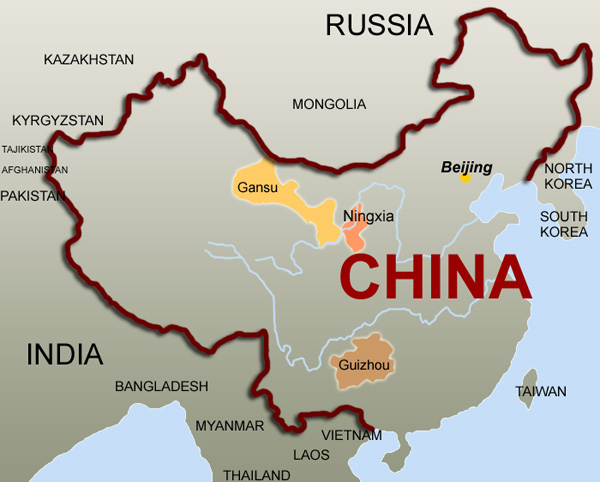Back in Beijing, researchers with Stanford's Rural Education Action Project take on digital divide
Our series: Stanford's Rural Education Action Project in China
China is the world's fastest-growing and second-largest economy, but it's the country's poverty that keeps Scott Rozelle coming back. As co-director of Stanford's Rural Education Action Project, Rozelle is looking for ways to give those struggling in the country's most remote areas the chance to make a living in the booming cities. REAP is one of many programs that has benefited over the last four years from The Stanford Challenge, a fundraising campaign dedicated to supporting people and programs seeking solutions to global problems.
For the past three summers, Rozelle has led what he calls a "mobile board meeting" of REAP's researchers, collaborators and donors who get a chance to review some of the group's projects and think up new ones. This year, the entourage focuses on REAP's work to eradicate childhood anemia and intestinal worms, and introduce computer-assisted learning in schools.
The field trip covers some of the country's poorest areas in the Guizhou, Gansu and Ningxia provinces. Adam Gorlick of the Stanford News Service traveled with the group and reports on their experiences.
Part 7: Computers help boost migrant children's grades
BEIJING, CHINA – Ask Zhang Qian why her family moved here from a rural village in another part of China, and the fifth-grader won't turn from her computer.
Try finding out if she likes living in the city, and she clicks a mouse. Forget about learning if she grew up on a farm. The only agriculture she's concerned with revolves around the animated carrots and chickens on her screen, the stars of a game that keeps asking her to figure out fractions.
If she gets too many questions wrong, she has to start the computerized lesson all over again.
Forgive the 11-year-old's lack of social graces. This computer game may be the key to improving her grades and giving her the edge she'll need to compete with kids born in Beijing and entitled to attend schools with better teachers, resources and promises for a higher education and a higher paying job.
"These kids are about two years behind their city peers," Stanford economist Scott Rozelle says about Qian and her fellow students at the Chunlei Migrant School, a private school in the Beijing suburbs. "Ask them if they want to go to high school and college, and they'll all say 'yes.' But they're not going to get there without a lot of help."
That help, Rozelle says, can come from the kind of computer-assisted learning programs that Qian can't pull away from.
Changing policy
A week before arriving at Chunlei, Rozelle and his colleagues from the Rural Education Action Project (REAP) spent a week traveling through China's impoverished countryside. In the lush, rocky province of Guizhou and the desolate deserts of Gansu and Ningxia, the group was studying the best ways to eradicate intestinal worms and curb high rates of anemia that stunt children's growth and keep them from doing well in school.
In some of those areas, as well as Beijing, they're taking on the problems of children being left behind in a digital divide.
Rozelle says the costs of a bad education and missed opportunities for China's youngest generation are too big for China to ignore. The creation of a disenfranchised class can destabilize the country and threaten its role as a major actor on the world's economic stage.
His goal is to influence Chinese policy with the results of his research and lead government officials to the decisions that will improve the health and education of the country's up-and-coming workforce.
"If we can create an effective intervention, we want policymakers to replicate it," Rozelle says.
More chances, new disadvantage
Like all the other students at Chunlei, Qian is the child of migrants who left their homes in the countryside for a shot at more money in the city. The work they find is often unpleasant. Factory jobs and construction work dominate, but their paychecks often swell to as much as four times what they were able to earn on farmland either too dry or too rocky to raise decent crops.
While many parents say the move is also motivated by the chance to give their children more opportunities, the kids find themselves with a new disadvantage once they arrive.
Government policy and lack of space in urban public schools essentially prohibit migrant children from access to good city schooling where education is free until high school. The rules have created a market for so-called migrant schools that charge parents tuition and operate with no oversight or regulation. There are about 500,000 children in migrant schools across Beijing, and they routinely underperform students in the city-run school system.
Boosting grades with computers
With more than 200 laptops donated by Quanta Computers, Rozelle designed a set of experiments to test how much impact computer-assisted learning would have on migrant students. The computers served as electronic tutors, delivering consistent, controlled and engaging lessons that are aligned with the student’s regular curriculum, that students can master at their own pace.
After 13 weeks of playing educational computer games, students raised their math scores on average from the equivalent of a C-plus to a B. And 20 percent of them said they started enjoying school more once they began using computers.
"This is a gigantic impact," Rozelle says. "In the U.S., we've spent billions to reduce class size and get those kinds of results. Here, we put computers in some classrooms and grades went up."
With the success of computer-assisted learning in migrant schools, Rozelle is now designing experiments to see how the technology can boost grades for the 20 million children attending rural schools throughout the country.
Dell Inc. pledged more than $500,000 for a computer-assisted learning program for third- and fifth-graders in the countryside of Shaanxi Province. REAP is now evaluating the program and Rozelle is thinking of ways to expand it to more rural areas and migrant communities.
A towering reminder
The Chunlei Migrant School is one of the better institutions of its kind in Beijing. While most people who run migrant schools are more concerned with making a profit than providing a good education, Rozelle says Chunlei's principal tries the best he can to raise student performance despite the difficulty of attracting good teachers willing to stay on his staff long enough to make a difference.
But he's open to ideas like computer-assisted learning, and his students seem happy. A group of them greets visitors with big smiles and crayon drawings. Outside, a student band practices while some kids scramble over piles of bricks, chunks of concrete and other debris to get to a playground and swingset.
Hulking behind the schoolyard is a power plant – its cooling towers and smokestacks a towering reminder of the enormous energy needed to fuel this city and help drive China's soaring economy.
- Part 1: Taking first steps toward fighting a pervasive parasite
- Part 2: Tackling a malady rooted in extreme poverty
- Part 3: To a barren plateau to address children's anemia
- Part 4: Solving the anemia problem: Is one egg enough?
- Part 5: Thin soup, mattresses of wood and a chance of ghosts
- Part 6: Finding the right mix of information and money to yield results
- Part 7: Computers help boost migrant children's grades
Media Contact
Adam Gorlick, Stanford News Service: (650) 725-0224, agorlick@stanford.edu



Share This Story